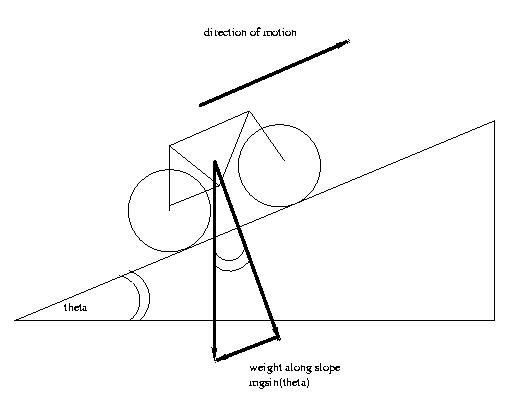
| MadSci Network: Physics |
Wind resistance is a large factor in many forms of racing. How much it matters is remarkably variable. Wind resistance is proportional to the surface area presented to the relative direction of the wind. In most general form
Wind Resistance = Geometric Factor * (Speed versus Wind)N
where the Geometric Factor is an empirical value -- that is arrived at by theoretical calculation or experimental testing, and the value of N depends a little bit on a few assumptions about the "quality" or turbulence of the wind. Typically N is between 1.0 and 2.0, but can change as the Speed versus Wind changes and as the wind changes speed. Some engineers and aeronautists have spent lifetimes dealing with drag or wind resistance.
A paceline will reduce wind resistance on the racers in the line, basically the poor chap at the front of the line bears the brunt of the wind/air resistance. This allows the trailers to conserve energy (discussed more later) because they do not need to "waste" energy (or power) to overcome the wind. This "drafting" effect is more useful at higher speed. The actual effect would be difficult to model accurately.
A few previous answers on wind resistance and drag might help you get a feel for some of the components that must be considered. Many of the same issues with aerodynamics of flight need to be addressed in ground racing. Remember, ground racing also has friction from the rolling components.
The effects of hill slope are very similar to all those incline plane
problems
people spend time worrying about in general physics courses. Basically the
steeper the slope the larger the component of weight the rider has to
overcome.
This is work in the true physics sense (Force dot displacement) and power.
The work
needed to climb a hill is Work = mass * gravity * change in height
and
the power is rate at which the work is done (Force dot velocity). So power
for
overcoming a hill is
Power to overcome gravity = mass * gravity * cosine (slope + 90) *
speed.
Note this is really an integral because the slope and speed can
change with position and time.

Consider two hills that rise to the same height: one gentle long hill and one steep tiring hill. A gradual hill is easier to overcome because the component of the gravity to overcome is smaller, and the power needed is less even though the work is the same. If the cyclist has to use power to overcome gravity then that power is lost for speed. Very roughly, speed squared is related to power. If 35% power must be spent to overcome gravity, then only 65% is available for speed, so speed is reduced to 42.25% (0.65 * 0.65). I stress this a very rough estimate based on energy produced at a constant rate (kinetic energy = 1/2 mass * speed 2).
Now suppose, you are the second guy in the paceline and the wind is reducing speed by 10%, you could ride at the same speed by spending 19% less power(1 - 0.902). This is a lot of energy/power saving especially over a long race. Some people even do this on the highway behind big trucks (do not do this it is irritating to the truck and dangerous).
Sincerely,
Tom "Training Wheels" Cull
Try the links in the MadSci Library for more information on Physics.